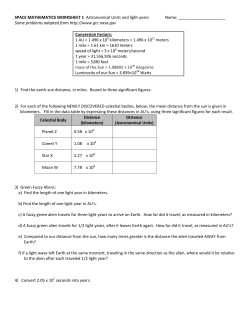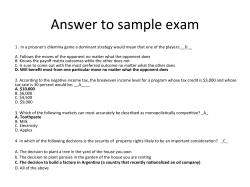
Section 2.4 Average Rate of Change of a Function
Section 2.4 Average Rate of Change of a Function Suppose you take a car trip and record the distance that you travel every few minutes. The distance s you have traveled is a function of the time t: s(t) = total distance traveled at time t We graph the function s as shown in the Figure below. The graph shows that you have traveled a total of 50 miles after 1 hour, 75 miles after 2 hours, 140 miles after 3 hours, and so on. To find your average speed between any two points on the trip, we divide the distance traveled by the time elapsed. Let’s calculate your average speed between 1:00 P.M. and 4:00 P.M. The time elapsed is 4−1 = 3 hours. To find the distance you traveled, we subtract the distance at 1:00 P.M. from the distance at 4:00 P.M., that is, 200 − 50 = 150 mi. Thus, your average speed is average speed = distance traveled 150 mi = = 50 mi/h time elapsed 3h The average speed we have just calculated can be expressed using function notation: average speed = s(4) − s(1) 200 − 50 = = 50 mi/h 4−1 3 Note that the average speed is different over different time intervals. For example, between 2:00 P.M. and 3:00 P.M. we find that average speed = s(3) − s(2) 140 − 75 = = 65 mi/h 3−2 1 Finding average rates of change is important in many contexts. For instance, we may be interested in knowing how quickly the air temperature is dropping as a storm approaches, or how fast revenues are increasing from the sale of a new product. So we need to know how to determine the average rate of change of the functions that model these quantities. In fact, the concept of average rate of change can be defined for any function. 1 EXAMPLE: For the function f (x) = (x − 3)2 , whose graph is shown in the Figure below, find the average rate of change between the following points: (a) x = 1 and x = 3 (b) x = 4 and x = 7 Solution: (a) Average rate of change = f (3) − f (1) (3 − 3)2 − (1 − 3)2 0−4 = = = −2 3−1 3−1 2 (b) Average rate of change = f (7) − f (4) (7 − 3)2 − (4 − 3)2 16 − 1 = = =5 7−4 7−4 3 2 EXAMPLE: If an object is dropped from a tall building, then the distance it has fallen after t seconds is given by the function d(t) = 16t2 . Find its average speed (average rate of change) over the following intervals: (a) Between 1 s and 5 s (b) Between t = a and t = a + h Solution: (a) Average rate of change = (b) Average rate of change = d(5) − d(1) 16(5)2 − 16(1)2 400 − 16 = = = 96 ft/s 5−1 5−1 4 d(a + h) − d(a) 16(a + h)2 − 16(a)2 16(a2 + 2ah + h2 − a2 ) = = (a + h) − a (a + h) − a h = 16(2ah + h2 ) h = 16h(2a + h) h = 16(2a + h) EXAMPLE: Let f (x) = 3x − 5. Find the average rate of change of f between the following points. (a) x = 0 and x = 1 (b) x = 3 and x = 7 (c) x = a and x = a + h What conclusion can you draw from your answers? Solution: (a) Average rate of change = f (1) − f (0) (3 · 1 − 5) − (3 · 0 − 5) (−2) − (−5) = = =3 1−0 1 1 (b) Average rate of change = f (7) − f (3) (3 · 7 − 5) − (3 · 3 − 5) 16 − 4 = = =3 7−3 4 4 (c) Average rate of change = f (a + h) − f (a) [3(a + h) − 5] − [3a − 5] 3a + 3h − 5 − 3a + 5 = = (a + h) − a h h = 3h =3 h It appears that the average rate of change is always 3 for this function. In fact, part (c) proves that the rate of change between any two arbitrary points x = a and x = a + h is 3. EXAMPLE: Let f (x) = mx + b. Find the average rate of change of f between the points x = a and x = a + h. Solution: We have Average rate of change = f (a + h) − f (a) [m(a + h) + b] − [ma + b] = (a + h) − a h = 3 mh ma + mh + b − ma − b = =m h h
© Copyright 2025





















